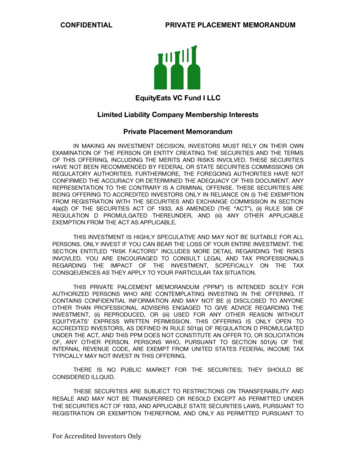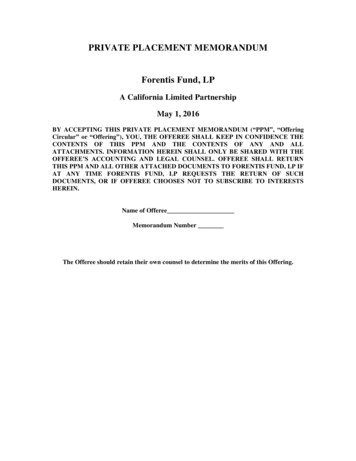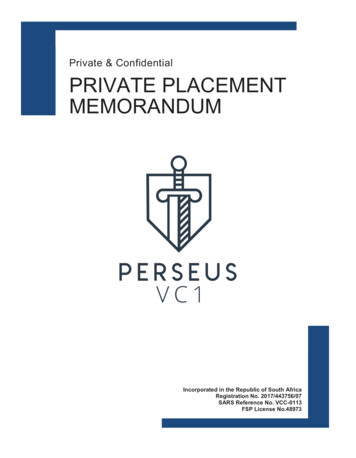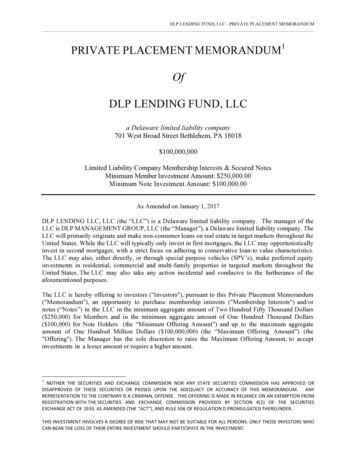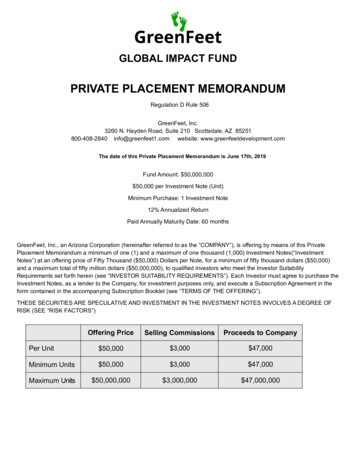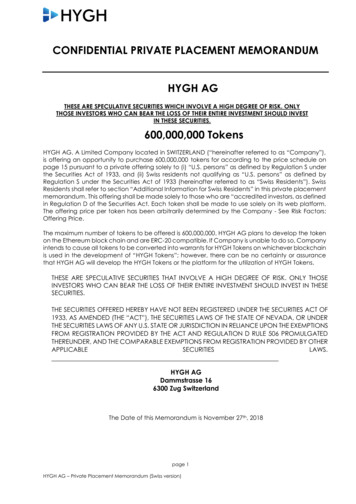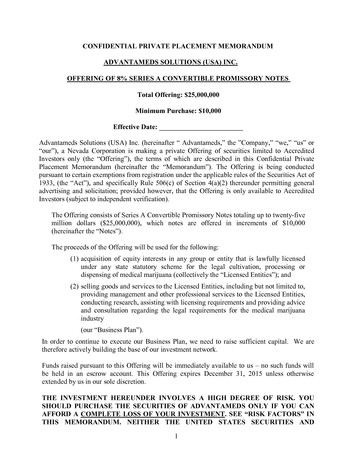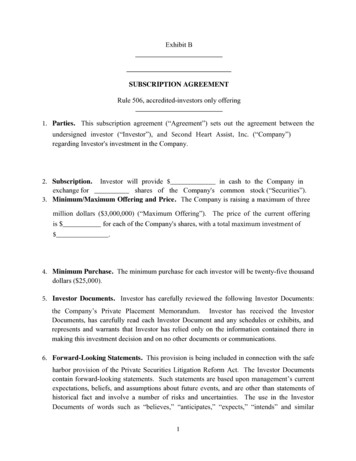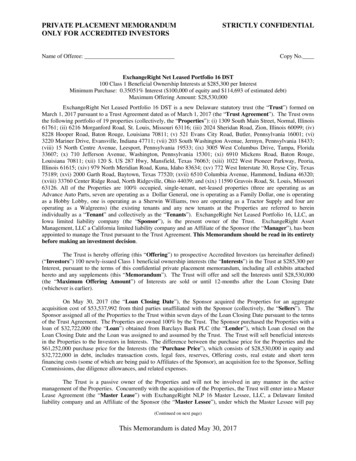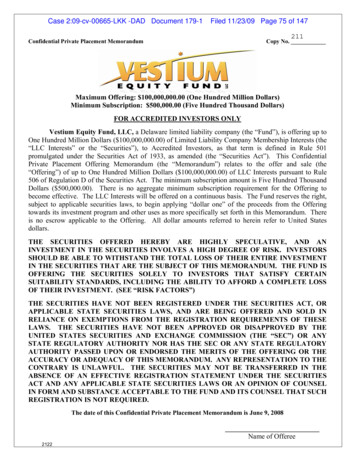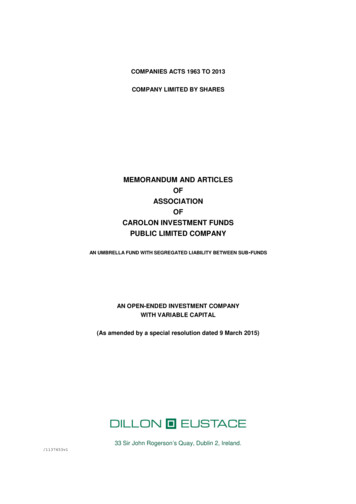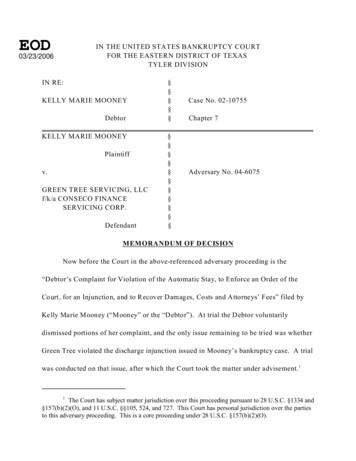
Transcription
EODIN THE UNITED STATES BANKRUPTCY COURTFOR THE EASTERN DISTRICT OF TEXASTYLER DIVISION03/23/2006IN RE:KELLY MARIE MOONEYDebtorKELLY MARIE MOONEYPlaintiffv.GREEN TREE SERVICING, LLCf/k/a CONSECO FINANCESERVICING CORP.Defendant§§§§§§§§§§§§§§§§Case No. 02-10755Chapter 7Adversary No. 04-6075MEMORANDUM OF DECISIONNow before the Court in the above-referenced adversary proceeding is the“Debtor’s Complaint for Violation of the Automatic Stay, to Enforce an Order of theCourt, for an Injunction, and to Recover Damages, Costs and Attorneys’ Fees” filed byKelly Marie Mooney (“Mooney” or the “Debtor”). At trial the Debtor voluntarilydismissed portions of her complaint, and the only issue remaining to be tried was whetherGreen Tree violated the discharge injunction issued in Mooney’s bankruptcy case. A trialwas conducted on that issue, after which the Court took the matter under advisement. 11The Court has subject matter jurisdiction over this proceeding pursuant to 28 U.S.C. §1334 and§157(b)(2)(O), and 11 U.S.C. §§105, 524, and 727. This Court has personal jurisdiction over the partiesto this adversary proceeding. This is a core proceeding under 28 U.S.C. §157(b)(2)(O).
This memorandum of decision disposes of all issues pending before the Court.Factual and Procedural BackgroundOn April 27, 1996, Kelly Marie Mooney and Christopher Mooney, then-married,executed a Manufactured Home Retail Installment Contract and Security Agreement (the“Contract”) for the purchase of a 1996 Schult-New Generation manufactured home,bearing serial number V401691.2 The Contract was subsequently sold to ConsecoFinance Servicing Corp. (“Conseco”), a predecessor-in-interest to the current Defendant,Green Tree Servicing, LLC f/k/a Conseco Finance Servicing Corp. (“Green Tree”). 3Conseco properly perfected its security interest in the manufactured home.4Unfortunately, Mooney and her husband encountered personal and financialdifficulties, resulting in a divorce in October, 2001. Soon thereafter, Mooney filed avoluntary petition under Chapter 7 of the Bankruptcy Code on January 29, 2002. Mooney2See Defendant’s Ex. A.3On December 17, 2002, Conseco Finance Corp., and its wholly owned subsidiaries, includingConseco Finance Servicing Corp., filed for relief under Chapter 11 of the Bankruptcy Code in the UnitedStates Bankruptcy Court for the Northern District of Illinois, Eastern Division (the “Conseco BankruptcyCourt”). See Defendant’s Ex. C. On or about March 14, 2003, the Conseco Bankruptcy Court entered anorder authorizing and approving an Asset Purchase Agreement between Conseco Finance Corp. and CFNInvestment Holdings, LLC (“CFN”). See Defendant’s Ex. D. The Asset Purchase Agreement providedfor the sale of certain of Conseco Finance Corp.’s assets, including its wholly owned subsidiary, ConsecoFinance Servicing Corp., to CFN, free and clear of any third party claims associated with the assets.Subsequent to the closing of the Asset Purchase Agreement, CFN changed the name of Conseco FinanceServicing Corp. to “Green Tree Servicing, LLC.” Among the assets purchased by CFN and subsequentlyowned by Green Tree was Conseco’s interests arising from the Contract and the related securitydocuments.4See Defendant’s Ex. B.-2-
properly listed Conseco as a creditor in her bankruptcy case, and Conseco was sent propernotice of the filing of her case on January 31, 2002.5 As Mooney no longer resided in themanufactured home after the divorce, she also filed a Statement of Intention in herbankruptcy case, dated January 29, 2002, declaring her intent to surrender themanufactured home to Conseco.6 This intent was subsequently confirmed to Conseco bythe Debtor’s attorneys on more than one occasion.7 After filing her bankruptcy case, theDebtor never resided in nor exercised any control over that home.On June 29, 2002, this Court granted to the Debtor a discharge under 11 U.S.C.§727 (the “Discharge Order”) which discharged the Debtor from personal liability on theindebtedness owed to Conseco secured by the manufactured home.8 The explanationaccompanying the discharge order provided the following information to all creditors:The discharge prohibits any attempt to collect from the debtor a debtthat has been discharged. For example, a creditor is not permitted tocontact a debtor by mail, phone, or otherwise, to file or continue a lawsuit,to attach wages or other property, or to take any other action to collect adischarged debt from the debtor. . . . A creditor who violates this order canbe required to pay damages and attorney’s fees to the debtor.However, a creditor may have the right to enforce a valid lien, such5See Ex. P-4.6See Ex. P-3.7See Ex. P-5 and P-8.8See Ex. P-7.-3-
as a mortgage or security interest, against the debtor’s property after thebankruptcy, if that lien was not avoided or eliminated in the bankruptcycase.9The discharge order was properly served on Conseco. As previously noted, Green Treeacquired the affected Contract on March 14, 2003.Green Tree contacted the Debtor on two occasions in March, 2004, ostensibly forthe purpose of seeking information about the Debtor’s ex-husband, Christopher M ooney.However, on March 29, 2004, Green Tree filed and served upon the Debtor an originalstate court petition against both the Debtor and Christopher Mooney in the 4th JudicialDistrict Court of Rusk County Texas under Case No. 2004-120 and styled Green TreeServicing, L.L.C. F/K/A Conseco Finance Servicing Corp. v. Christopher M. Mooney andKelly M. Mooney (the “State Court Lawsuit”).10 Though entitled as a “Plaintiff’s OriginalPetition for Lien Foreclosure,” the state court petition demanded that a money judgmentbe entered against the Debtor for reasonable and necessary attorney’s fees, costs of Court,with post-judgment interest accruing until paid.11Green Tree was aware that Mooney no longer occupied the manufactured home forsome time prior to May, 2004. In fact, the state court petition filed by Green Tree onMarch 29, 2004 stated Green Tree’s belief that Mooney could be served at her new9See Discharge of Debtor entered in case # 02-10755 on June 29, 2002 (dkt #9).10See Ex. P-9.11Id.-4-
address — 206 Alberta Avenue in Henderson, Texas. On May 3, 2004, Green Tree fileda “Motion for Substituted Service” in the State Court Lawsuit seeking authority to servethe Debtor by posting the citation at that new address. 12 Yet on May 13, 2004, GreenTree, through its authorized agent and representative, Kendra Dunn, contacted the Debtorby telephone with the purported purpose of identifying the Debtor’s location so that shemight be served with the state court petition. Dunn claims that she was not personallyaware of Mooney’s bankruptcy discharge at the time of that call, but had she fullyinvestigated Green Tree’s file regarding Mooney, she would have become aware of thedischarge order. 13During the May 13th telephone call with the Debtor, Dunn threatened that if GreenTree was not able to serve her personally, it would go “public.” Mooney asked what“going public” meant, and Dunn explained that Green Tree would publish the existenceof the lawsuit in the local newspaper in order to achieve service and people in that areawould learn that she had not paid her debts. Though Green Tree had previously beenmade aware of both Mooney’s intention to surrender the manufactured home, and the factthat she did not currently reside at the location of that home, Mooney nevertheless again12See Ex. P-10. Such service was accomplished on May 17, 2004.13Green Tree maintained records regarding the Debtor in three different places: in a computersystem reflecting only events in the most recent year, in another computer system reflecting informationover a year old, and in an imaging area containing copies of written documents relevant to a particularfile. Though Dunn acknowledged that the computer screen immediately available to her should havereflected Mooney’s bankruptcy discharge, it apparently did not due to some unexplained internal failureat Green Tree. Nevertheless, other files maintained by Green Tree and available to the collection agentupon inquiry did reflect Mooney’s discharge.-5-
advised the Green Tree representative of these facts.On May 20, 2004, the Debtor filed in her bankruptcy case a “Motion to ReopenCase to File Suit Against Creditor for Injunction to Prevent Further Violations of theDischarge Order and to Recover Damages, Costs and Attorneys Fees Related toViolations of the Automatic Stay and Discharge Order.” 14 The motion to reopen allegedas grounds for reopening the case “a knowing, persistent, and continuing violation of .the discharge order” by Green Tree. The motion to reopen was served upon ThomasCorea and Dunham Biles, the attorneys of record for Green Tree in the State CourtLawsuit, on May 20, 2004. Though one would expect that service of such a motionwould cause the recipient and its representatives to cease all efforts with respect to theaccount, at least until the matter could be investigated, the motion had no such effect onGreen Tree’s state court attorneys .On May 24, 2004, Green Tree, through Dunn, again contacted the Debtor bytelephone. The May 24th telephone call was considerably longer than the calls the Debtorhad earlier received from Green Tree in March and on May 13. When Dunn asked theDebtor whether she had passed information to her ex-spouse as Green Tree had earlierrequested, the Debtor’s acknowledgment that she had not and would not contact her exspouse on Green Tree’s behalf changed the tenor of the conversation. Dunn told theDebtor that this collection issue was, and would continue to be, her problem because she14See Ex. P-13.-6-
was equally responsible for payment of the Contract, and that Green Tree just wantedpayment on the mobile home. The Debtor told Dunn that she was not liable for theindebtedness, and if Dunn wanted to know why, she could check Green Tree’s file or callthe Debtor’s attorney.15 Eventually, the Debtor stated that she did not care if the mobilehome burned, and Dunn then falsely represented to the Debtor that she would beresponsible for payments on the home even if it burned. At the end of the May 24thphone call, Dunn informed the Debtor that she would be calling back in two weeks. 16On June 1, 2004, the Debtor filed an answer to the State Court Lawsuit andasserted the discharge in bankruptcy as a defense.17 The answer was properly served onGreen Tree’s state court attorney. Despite the repeated warnings to Green Tree that itspursuit of contract damages against Mooney constituted a violation of the dischargeinjunction, as was clearly expressed to Green Tree’s legal representatives in the motion toreopen the Debtor’s bankruptcy case and the state court answer, Green Tree continued its15Green Tree asserted at trial that the Debtor had some affirmative duty to inform Dunn of thebankruptcy discharge. While it may have been reasonable for the Debtor to have done so, Green Treehad already been provided with the notice of the discharge order to which it was legally entitled.Furthermore, the Debtor was understandably frustrated with Green Tree and its predecessor and herfrustration elucidates her evasive behavior. Throughout the course of her bankruptcy case, and for asubstantial period of time after the entry of the discharge order, the Debtor was repeatedly contacted byGreen Tree representatives about her intentions with respect to the debt and the collateral, even thoughher intentions regarding that issue had been clearly communicated on numerous occasions. Suchconstant pestering by a company which was obviously not reviewing its own business records, andparticularly in the light of the completion of a Chapter 7 case, would frustrate the most patient of persons.16Dunn never actually called back because the case was reassigned to another collector due toan unrelated change in Dunn’s responsibilities.17See Ex. P-15.-7-
pursuit of the remedies in the State Court Lawsuit. On June 14, 2004, Green Tree filed aMotion for Summary Judgment and a proposed form of judgment against the Debtor inthe State Court Lawsuit. 18 The terms of the proposed judgment submitted by Green Treewould have granted to Green Tree an award of attorney’s fees, costs, and post-judgmentinterest.19 In failure of its obligations as a litigant, Green Tree’s state court attorneysfailed to serve a copy of the motion for summary judgment upon McNally & Patrick,L.L.P., the Debtor’s attorneys of record in the State Court Lawsuit.On June 16, 2004, Green Tree, through its attorneys, did serve upon the Debtor’slawyers a Notice of Hearing regarding the Plaintiff’s Motion for Summary Judgmentwhich had been filed in the State Court Lawsuit. 20 Having received notice of a hearing ona motion for summary judgment which he had never received, much less responded to,Michael J. McNally attempted to contact Green Tree’s attorneys on behalf of the Debtor.On June 25, 2004, Mr. McNally sent a letter to Green Tree’s state court attorney, ThomasM. Corea, which: (1) requested a copy of the Motion for Summary Judgment which hadbeen filed; and (2) demanded that Green Tree cease all of its collection efforts against theDebtor. The letter noted that:The Bankruptcy Court has entered an Order granting Kelly Mooney’sMotion to Reopen her case. The case has been reopened for the reasons18See Ex. P-17.19See Ex. P-18.20See Ex. P-19.-8-
stated in the Motion, which include filing a complaint to prevent furtherviolations of the discharge order by your client.21Neither Mr. Corea nor any other Green Tree representative ever timely responded to theDebtor’s June 25th request. 22On August 3, 2004, the Debtor filed a response to Green Tree’s Motion forSummary Judgment in the State Court Lawsuit. Such response was properly served uponthe designated attorneys for Green Tree and included an affidavit from the Debtorsupporting her defense to the State Court Lawsuit that the debt had been discharged inbankruptcy. Finally, after the initiation of this adversary proceeding and in light of thepending hearing on the motion for summary judgment, Green Tree non-suited the Debtorfrom the State Court Lawsuit on August 13, 2004, but without prejudice to the refiling ofthe petition against Mooney at some future time.DiscussionA discharge “operates as an injunction against the commencement or continuationof an action, the employment of process, or an act to collect, recover, or offset.as apersonal liability of the debtor” any debt discharged under section 727. 11 U.S.C.21See Ex. P-20.22A copy of the Motion for Summary Judgment was finally provided to McNally & Patrick,L.L.P. on August 3, 2004 by the new counsel retained by Green Tree to defend the complaint filed in thisproceeding, but not before Mr. McNally had been forced to acquire a copy from the Rusk County DistrictClerk.-9-
§524(a)(2). Congress clearly set forth the purpose of this section in the legislativehistory, noting:The injunction is to give complete effect to the discharge and to eliminateany doubt concerning the effect of the discharge as a total prohibition ondebt collection efforts. This paragraph has been expanded . to cover anyact to collect, such as dunning by telephone or letter, or indirectly through .harassment, threats of repossession and the like. The change is . intendedto ensure that once a debt is discharged, the debtor will not be pressured inany way to repay it.H.R.Rep. No. 595, 95th Cong., 1st Sess. 363-64 (1978); S. Rep. No. 959, 95th Cong., 2dSess. 80 (1978).The United States Supreme Court recently described the protection which a debtorderives from the entry of a discharge order as one of the “[c]ritical features of everybankruptcy proceeding. . . .” Cent. Virginia Cmty. Coll. v. Katz, U.S. , 126 S.Ct.990, 996, 74 U.S.L.W. 4101 (2006). As one court addressing the violation of a dischargeinjunction has stated,[T]he basic purpose of the bankruptcy system is to provide the debtor with a“fresh start.” . . . Discharge is the legal embodiment of the “fresh start.” Itis the barrier that prevents creditors from reaching the wages, property, andother assets of debtors in bankruptcy. In other words, discharge establishesa legal right not to pay a debt and safeguards against harassment by thecreditor. . . .Walker v. M & M Dodge, Inc. (In re Walker), 180 B.R. 834, 840-41 (Bankr. W.D. La.1995).In fact,-10-
The automatic stay and discharge injunction are cornerstones of bankruptcylaw. They are, respectively, a fundamental debtor protection and afundamental debtor objective. The automatic stay assists debtors inregaining their financial footing by allowing them to do so free fromcollection efforts. And, having successfully completed the bankruptcyprocess, discharge provides debtors with a new opportunity in life and aclear field for future effort, unhampered by the pressure anddiscouragement of pre-existing debt. But the automatic stay and dischargeinjunction must be enforced to provide any meaningful protection orincentive.Curtis v. LaSalle Nat’l Bank (In re Curtis), 322 B.R. 470, 483 (Bankr. D. Mass. 2005)(internal citations and quotations omitted). Indeed, when a discharge injunction isviolated, a debtor is denied one of the primary benefits offered by the present bankruptcysystem.In the present case, it is undisputed that Mooney’s debt to Green Tree wasdischarged under 11 U.S.C. §727. However, there is also no dispute that the lien held byGreen Tree survived the bankruptcy, and Green Tree continued to hold rights against themanufactured home as its collateral on the discharged debt. The juxtaposition of thecontinued existence of a lien, but with no corresponding personal liability for a debtor,creates an awkward situation wherein a creditor may legitimately possess a reason tocommunicate with a debtor in the post-discharge period. See, e.g., In re Garske, 287 B.R.537 (B.A.P. 9th Cir. 2002). However, in this instance, Mooney properly informed thecreditor of her intent to surrender the collateral through the processes mandated by the-11-
Bankruptcy Code, and at no time subsequent to that indication of intent did she ever actcontrary to that stated intent. As such, it should not have even been necessary for GreenTree to contact the Debtor. However, even if Green Tree is given the benefit of the doubtregarding its initial contacts with the Debtor, it certainly had no legal basis to assert, as itdid repeatedly in this case, that the Debtor was still legally liable to Green Tree. WhileGreen Tree was always free to pursue its collateral in rem, the nature of its statements tothe Debtor during this time period and its independent post-discharge actions to obtain amoney judgment against the Debtor clearly crossed the line of propriety.Green Tree asserts that its telephonic communications, though perhaps improper,were not an attempt to collect a debt as proscribed by §524(a)(2). The evidencedemonstrates otherwise. Green Tree’s post-discharge threats to “go public,” which wereintended to intimidate the Debtor into complying with its demands, eroded the safeguardsagainst harassment which the discharge injunction represents and undermined the freshstart to which the Debtor was entitled. Green Tree further violated the dischargeinjunction by its filing of a post-discharge lawsuit seeking a recovery of a personaljudgment against the Debtor, thereby triggering the necessity for the Debtor to engagelegal representation for protection, thereby further undermining the purposes of thedischarge injunction.Yet Green Tree did not stop there. Its actions went beyond mere threats and evenbeyond the illegitimate filing of a state court petition seeking an in personam judgment.-12-
Even after the Debtor’s attorney filed the motion to reopen the bankruptcy case, therebyagain informing Green Tree of its ongoing violations of the discharge injunction, GreenTree willfully plowed ahead with its strategy, continuing to contact the
5 See Ex. P-4. 6 See Ex. P-3. 7 See Ex. P-5 and P-8. 8 See Ex. P-7.-3-properly listed Conseco as a creditor in her bankruptcy case, and Conseco was sent pr oper notice of the filing of her case on January 31, 2002.5 As Mooney no longer resided in the manufactured home after t he divorce, she also filed a Statement of Intention in her
